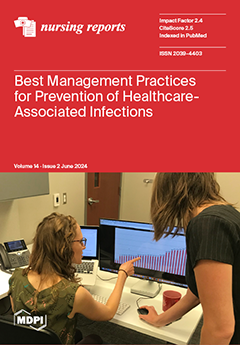Background: The use of standardized patient simulation in psychiatric nursing education addresses the unique challenges presented by mental healthcare settings. Students’ attitudes toward clinical simulation remain predominantly favorable, with many expressing enthusiasm for the opportunities it provides in terms of embracing challenges, enhancing
[...] Read more.
Background: The use of standardized patient simulation in psychiatric nursing education addresses the unique challenges presented by mental healthcare settings. Students’ attitudes toward clinical simulation remain predominantly favorable, with many expressing enthusiasm for the opportunities it provides in terms of embracing challenges, enhancing realism, and promoting critical thinking through problem solving, decision-making, and adaptability.
Methods: This quantitative study used a cross-sectional, descriptive, correlation design to investigate the effectiveness of standardized patient simulation as a teaching method in the Psychiatric and Mental Health nursing course in a university setting. A total of 84 nursing students were recruited for the convenience sample. Data were collected using a three-part questionnaire survey which included the following: a demographic data sheet, the Student Satisfaction and Self-confidence in Learning Scale, and a narrative open-ended question asking the participants to write the advantages and disadvantages of their simulation experience. Data were analyzed using the statistical software JMP pro17.
Results: The total satisfaction with learning subscale score ranged between 5 and 25 with a mean score of 19.36 ± 6.32. The total self-confidence subscale score ranged between 8 and 40 with a mean score of 30.87 ± 9.1. Pearson’s correlation coefficient r revealed a statistically significant positive relationship between the participants’ satisfaction with the learning experience and their self-confidence (t = 0.923,
p < 0.0001). Approximately 91.7% of the students recommended using simulation. The results confirmed the students’ recommendations of simulation use in teaching psychiatric and mental health courses; furthermore, the results showed a statistically significant positive correlation with the total SSLS (
p = 0.01) and satisfaction with learning subscale (0.003). Participants reported that authentic, practical, comfortable, and safe learning environments contributed to an enriched learning experience. Additionally, factors such as timesaving, access to information, cost-effectiveness, standardized teaching, varied exposure, skill development, and immediate feedback also enhanced the learning experience through patient simulation in psychiatric and mental health nursing.
Conclusion: Simulations can contribute efficiently and positively to psychiatric and mental health nursing education in a manner that optimizes the learning experience while ensuring the consistency of student learning in a safe learning environment.
Full article






